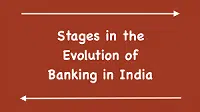
The following passage is all about Evolution Of Banking in India.Read and find out about history of banking in india.
Evolution of Banking in India
Banking in India traces its origin in the latter half of the eighteenth century. The first banks to come up were Bank of Hindustan (1770-1829) and the General Bank of India, established in 1786 and since defunct. Then came the three presidency banks—Bank of Calcutta, Bank of Bombay and Bank of Madras, all of which were established under charters from the British East India Company. The three banks merged in 1921 to form the Imperial Bank of India. The Reserve Bank of India (RBI) was also set-up in 1935.
Post independence, what followed were significant changes in the banking industry. Especially, in the year 1949, two major actions were taken post-independence important from the point of view of structural reforms. First, the Banking Regulation Act was passed. It gave extensive powers to the RBI over the commercial banks. Another development of no less importance was the nationalisation of RBI.
In 1955, the Imperial Bank of India came to be known as the State Bank of India. Its 92% of shares were acquired by RBI. In 1959 the State Bank of India (Associate Banks) Act was passed and this paved the way for creating the State Bank Group. Now, State Bank of Hyderabad, State Bank of Jaipur, etc constitute the State Bank Group. The process of nationalisation continued till 1969 and on 19th July 1969, fourteen of the nineteen commercial banks were nationalised.
However, the nationalisation process could not do much to solve the problem of rural indebtedness. Therefore, a new type of banking institution called Regional Rural Banks was conceived. Regional rural banks were set-up under an act of 1976.
These banks meet the credit requirements of weaker sections, small and marginal farmers, landless labourers, artisans and small entrepreneurs. Owing to the nationalisation of banks, banking has been dominated by public sector banks, however, since liberalisation in government banking policy in the 1990s, old and new private sector banks have re-emerged.
They have grown faster and bigger over the two decades since liberalisation using the latest technology, providing contemporary innovations and monetary tools, and techniques. ING Vysya, Federal Bank, City Union Bank are some of the examples of pre-liberalisation private banks. New or post liberalisation private banks are Axis Bank, ICICI Bank, Yes Bank etc.
Today, the foreign banks are equally an important sector of the industry as the other banks. With a network of 334 branches, the 43 foreign banks account for 70k of assets and little over 15% of capital, reserves and surplus of the industry. Bank of America, Standard Chartered Bank, HSBC are some of the well-known foreign banks in the country.
The banking industry, in the last two decades, has made many strides. With advancements in technology, we have seen ATMs, the debit and credit cards (plastic money) obviate the need for customers to make regular trips to the bank to make payments. Similarly, the convenience of SMS banking, phone banking and internet banking relieve the customers from the stress of going to the banks every time for any enquiry.
The banks have also expanded its arena of operations. Apart from being the custodian of deposits and credit lenders, banks now also offer investment schemes and insurance policies.
The launch of Bhartiya Mahila Bank—India’s first all women’s bank in 2013 is another feather in the cap of the Indian banking industry.
Hence, the Indian banking industry has been booming since its inception and with the Indian economy projected to grow further to become one of the largest economies in the world, the banking sector in India is poised to grow along with it.